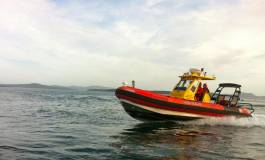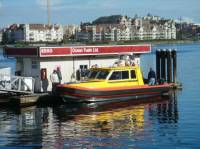





October 23rd, 2006
October 23rd, 2006
Volunteers take to the waves
Just about anywhere around Sooke or the South Island, whether there is an ocean view or not, life is dominated by the sea. The weather conditions we endure come at us from the water. So, too, come salmon, halibut, and the people who seek them and other kinds of fish, along with whale watchers. They all help to stimulate the local economy. Ready to leap into action when someone on the water gets into trouble is the Canadian Coast Guard Auxiliary.On the west coast there are 53 units of the CCGA. Looking out for mariners along this particular stretch of coastline are the members of the local station. Like all units of the CCGA the local group is made up of volunteers and is supported by a society - in the case of the local unit, the Juan de Fuca Marine Rescue Society (JDRMRS).
The workload of local auxiliary members is impossible to predict, but its a safe bet someone could be in grave peril whenever the call for action goes out. Day or night, any time of the year, as long as there are three members to staff the rescue craft a team will head out to respond to the call.
George Holmes wears a pager for the local auxiliary, its a pursuit he is able to take part in due to the fact that he lives and works within a 15 minute drive of the dock at the foot of Maple Road.
Holmes took time out last Friday to talk to the Sooke News Mirror about the marine rescue group and some of the challenges it deals with.
The JDFMRS raises funds for the local unit, and at times the amount of funds is considerable.
Case in point: the 30-foot rigid-hull inflatable with the twin 250-horsepower outboards and fully sealed cabin that is the main apparatus of the local members. The boat came with a cost of about $200,000 and has upped the rescue capability immeasurably. Holmes said it was christened very early this year, and was delivered in April.
"On the water we cover the area from Race Rocks to the Nitinat River (north of Port Renfrew)," said Holmes. "Its one of the largest areas of ocean of any of the units."
Acquiring a new boat takes a good deal of planning and coordinated effort, as Holmes described.
"About four years ago we started raising money to replace our other boat," he said. "Because were a non-profit society a lot of our funding comes from gaming revenues. But now that we have the boat, the Coast Guard Auxiliary does cover our fuel costs when were out on training and when were out on search and rescue missions, or incidents."
Due to inevitable wear and tear and the need for miscellaneous equipment, however, ongoing fundraising efforts are required of the unit and society.
"Some of our funds come from the municipalities," said Holmes. "The District of Sooke is one of our main contributors; the Juan de Fuca Electoral District; Metchosin has been a funder, and also View Royal. And a lot of groups such as the Legion, the Rotary...etc. We might identify some equipment we need and they will donate money to the society."
Unit members themselves are also likely to be involved in any number of fundraising efforts that are organized.
"We have a booth at the Canada Day celebrations, and the Rotary Auction," said Holmes. "So were selling hamburgers and fries and things of that nature."
Another source of funding for the safeguarding group may often arrive in the form of donations from rescue parties, although there is not actual charge for the service. There has been much debate about who should be responsible for the cost of rescue, and some feel it should be passed on to those who create the need. The idea has been broached with regard to the many rescues carried out on the Mainlands North Shore Mountains, for example. For now, the marine rescues remain a free service.
"Were just working on a website right now," said Holmes, "where we could just give someone the address, and if they want to go in it would show them how to make a donation if they wanted to."
The rescue group also provides pleasure-craft courtesy checks, a valuable service for boaters.
Holmes says the upgraded boat used by his unit is a huge step up from what they were using before. They have shelter from the elements, that, in a speeding boat in bad weather, can be understandably harsh. There are four shock-absorbing seats that can be customized for the size and weight of their helmeted occupants, and there is a full complement of high-tech navigation equipment.
Holmes was asked if there is any kind of weather in which the volunteers would not go out, and he said, basically, no.
He did state that the minimum of three crew members is a stipulation that is adhered to.
That brings up the topic of volunteer numbers, and the fact that some new blood to bolster the ranks would not go unappreciated.
The members have answered 25 calls for help since April.
"We have a lot of members who are inactive," said Holmes. "They havent been out to meetings in a while. We have about a dozen people who are doing 90 per cent of the calls."
There are two shifts looked after by the volunteers - day crew and night crew.
"Day crew is 6 a.m. to 6 p.m.," he said. "Night crew is 6 p.m. to 6 a.m. plus weekends. If you have enough members you would carry a pager one week out of five. Ive had the pager since the end of January, with no break," stated Holmes.
That being said, Holmes did include the fact that there is much to enjoy in the duty, as well as a tremendous amount of satisfaction in helping others.
The group is changing the night of its meetings to Wednesday in the hope of attracting potential recruits. Some nautical experience would come in handy, along with consistent availability.
Holmes said the number to call for information is listed in the Greater Victoria "Canadian Directories" phone book as the Sooke Marine Rescue Society. The number is 642-4644.
- article from the Sooke News Mirror, October 4, 2006 edition
| RSS feed | Feed Description |
|---|---|
| Complete RSS feed | |
| RSS feed for: What´s New | |
| A Rich Site Summary (RSS) feed is an xml data file that provides a summary of the information contained here. It is not designed to be viewed in your browser, but instead by rss reader software. If you do not know what this means - you can safely ignore it, as it is provided for advanced users with rss reader software only. | |
